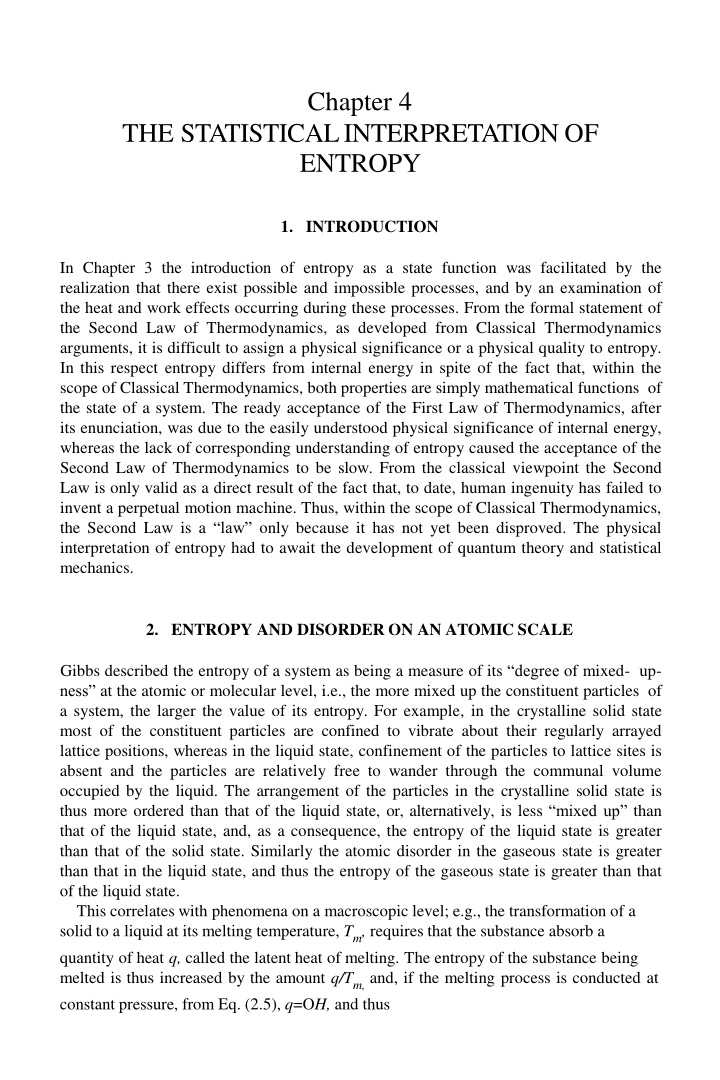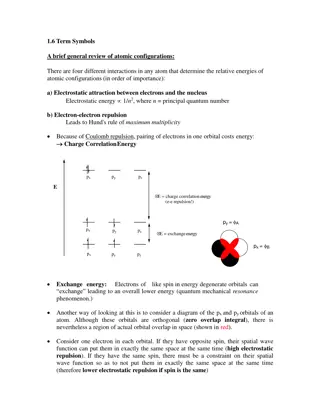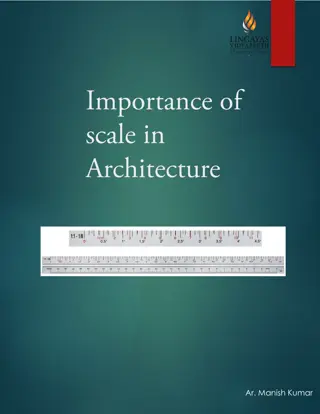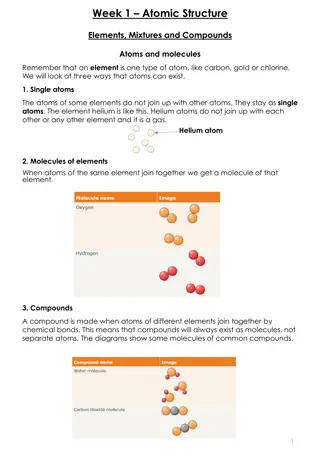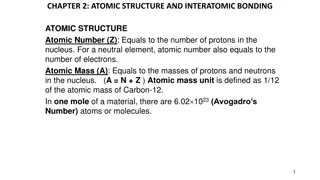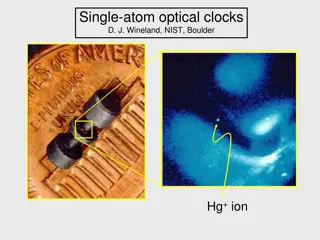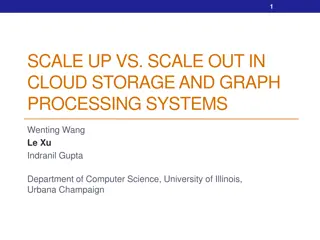Statistical Interpretation of Entropy - Introduction and Atomic Scale Disorder
In Chapter 4, the concept of entropy as a state function is explored further, focusing on its physical significance and relation to disorder at the atomic level. Entropy in different states of matter is discussed, highlighting the correlation between disorder and entropy changes during phase transitions like melting and freezing. The influence of latent heat on entropy and disorder is examined, providing insights into the interplay of thermodynamic processes on a microscopic scale.
Download Presentation

Please find below an Image/Link to download the presentation.
The content on the website is provided AS IS for your information and personal use only. It may not be sold, licensed, or shared on other websites without obtaining consent from the author.If you encounter any issues during the download, it is possible that the publisher has removed the file from their server.
You are allowed to download the files provided on this website for personal or commercial use, subject to the condition that they are used lawfully. All files are the property of their respective owners.
The content on the website is provided AS IS for your information and personal use only. It may not be sold, licensed, or shared on other websites without obtaining consent from the author.
E N D
Presentation Transcript
Chapter 4 THE STATISTICAL INTERPRETATION OF ENTROPY 1. INTRODUCTION In Chapter 3 the introduction of entropy as a state function was facilitated by the realization that there exist possible and impossible processes, and by an examination of the heat and work effects occurring during these processes. From the formal statement of the Second Law of Thermodynamics, as developed from Classical Thermodynamics arguments, it is difficult to assign a physical significance or a physical quality to entropy. In this respect entropy differs from internal energy in spite of the fact that, within the scope of Classical Thermodynamics, both properties are simply mathematical functions of the state of a system. The ready acceptance of the First Law of Thermodynamics, after its enunciation, was due to the easily understood physical significance of internal energy, whereas the lack of corresponding understanding of entropy caused the acceptance of the Second Law of Thermodynamics to be slow. From the classical viewpoint the Second Law is only valid as a direct result of the fact that, to date, human ingenuity has failed to invent a perpetual motion machine. Thus, within the scope of Classical Thermodynamics, the Second Law is a law only because it has not yet been disproved. The physical interpretation of entropy had to await the development of quantum theory and statistical mechanics. 2. ENTROPY AND DISORDER ON AN ATOMIC SCALE Gibbs described the entropy of a system as being a measure of its degree of mixed- up- ness at the atomic or molecular level, i.e., the more mixed up the constituent particles of a system, the larger the value of its entropy. For example, in the crystalline solid state most of the constituent particles are confined to vibrate about their regularly arrayed lattice positions, whereas in the liquid state, confinement of the particles to lattice sites is absent and the particles are relatively free to wander through the communal volume occupied by the liquid. The arrangement of the particles in the crystalline solid state is thus more ordered than that of the liquid state, or, alternatively, is less mixed up than that of the liquid state, and, as a consequence, the entropy of the liquid state is greater than that of the solid state. Similarly the atomic disorder in the gaseous state is greater than that in the liquid state, and thus the entropy of the gaseous state is greater than that of the liquid state. This correlates with phenomena on a macroscopic level; e.g., the transformation of a solid to a liquid at its melting temperature, Tm, requires that the substance absorb a quantity of heat q, called the latent heat of melting. The entropy of the substance being melted is thus increased by the amount q/Tm,and, if the melting process is conducted at constant pressure, from Eq. (2.5), q=OH, and thus
78 Introduction to the Thermodynamics ofMaterials The increase in the entropy of the substance which accompanies melting correlates with the corresponding increase in the degree of disorder of its constituent particles. The above correlation does not apply at all temperatures, because, if a supercooled liquid spontaneously freezes, it might appear that a decrease in the degree of disorder causes an increase in entropy (the entropy produced by the irreversible freezing process). The apparent anomaly is removed by considering the influence of the latent heat of freezing released on the entropy and degree of disorder of the heat reservoir which absorbs the heat. If spontaneous freezing of a supercooled liquid occurs, the increase in the degree of order of the freezing system is less than the decrease in the degree of order in the heat reservoir, and hence the spontaneous freezing process causes an overall increase in disorder and an overall increase in entropy. If the transformation from liquid to solid occurs at the equilibrium melting temperature of the substance, Tm, then the increase in the degree of disorder of the heat reservoir equals the decrease in the degree of disorder of the substance, and the total degree of disorder of the combined system is unchanged; disorder has simply been transferred from the substance to the heat reservoir. Consequently, the entropy of the combined system is unchanged as a result of the freezing process; entropy has simply been transferred from the substance to the heat reservoir. The equilibrium melting or freezing temperature of a substance can thus be defined as that temperature at which no change in the degree of order of the combined system (substance+heat reservoir) occurs as a result of the phase change. Only at this temperature are the solid and liquid in equilibrium with one another, and hence, only at this temperature can the phase change occur reversibly. 4.3 THE CONCEPT OFMICROSTATE The development of a quantitative relationship between entropy and degree of mixed- up-ness requires quantification of the term degree of mixed-up-ness, and this can be obtained from a consideration of elementary statistical mechanics. Statistical mechanics arises from the assumption that the equilibrium state of a system is simply the most probable of all of its possible states, and the subject is concerned with determination of, the criteria governing, and the properties of this most probable state. One of the major developments in physical science which has led to a considerable increase in the understanding of the behavior of matter is the quantum theory. A postulate of the quantum theory is that, if a particle is confined to move within a given fixed volume, then its energy is quantized, i.e., the particle may only have certain discrete allowed values of energy, which are separated by forbidden energy bands. For any given particle the spacing between the quantized values of energy (the allowed energy levels) decreases as the volume available to the movement of the particle increases, and energy becomes continuous only when no restriction is placed on the position of the particle.
The Statistical Interpretation of Entropy 79 The effect of the quantization of energy can be illustrated by considering a hypothetical system comprising a perfect crystal in which all of the lattice sites are occupied by identical particles. The characteristics of the particles and the crystal structure determine the quantization of the allowed energy levels, in which the lowest energy level, or the ground state, is designated s0, and the succeeding levels of increasing energy are designated s1, s2, s3, etc. The crystal contains n particles and has the energy U,and statistical mechanics asks the questions: In how many ways can the n particles be distributed over the available energy levels such that the total energy of the crystal is U, and, of the possible distributions, which is the most probable? Consider that the crystal contains three identical, and hence indistinguishable, particles which are located on three distinguishable lattice sites A, B, and C. Suppose, for simplicity, that the quantization is such that the energy levels are equally spaced, with the ground level being taken as zero, the first level s1=u, the second level s2=2u, etc., and let the total energy of the system be U=3u. This system has three different distributions, as shown in Fig. 4.1. Figure 4.1 The distributions of particles among energy levels in a system of constantenergy. Figure 4.2 Illustration of the complexions or microstates within distri- butions of particles among energy levels in a system of constant energy. a. All three particles in level 1 b. One particle in level 3, and the other two particles in level 0 c. One particle in level 2, one particle in level 1, and one particle in level 0 These distributions must now be examined to determine how many distinguishable arrangements they individually contain.
80 Introduction to the Thermodynamics of Materials Distribution a. There is only one arrangement of this distribution, as interchange of the particles among the three lattice sites does not produce a different arrangement. Distribution b. Any of the three distinguishable lattice sites can be occupied by the particle of energy 3u, and the remaining two sites are each occupied by a particle of zero energy. As interchange of the particles of zero energy does not produce a different arrangement, there are three arrangements in distribution b. Distribution c. Any of the three distinguishable lattice sites can be occupied by the particle of energy, 2u, either of the two remaining sites can be occupied by the particle of energy, 1u, and the single remaining site is occupied by the particle of zero energy. The number of distinguishable arrangements in distribution c is thus 3 2 1 3!=6. These arrangements are shown in Fig. 4.2. Thus, there are 10 distinguishable ways in which three particles can be placed in the energy levels such that the total energy of the system, U, equals 3u. These distinguishable arrangements are called complexions or microstates, and all of the 10 microstates correspond to a single macrostate. 4.4 DETERMINATION OF THE MOST PROBABLEMICROSTATE The concept of macrostate lies within the domain of Classical Thermodynamics, and the macrostate is fixed when the values of the independent variables are fixed. As was shown in Chap. 1, a system of fixed composition has three independent variables the original two plus a variable which describes the size of the system. In the above example the values of U, V, and n are fixed (constancy of volume being required in order that the quantization of the energy levels be determined), and hence the macrostate of the system is fixed. With respect to the microstates within any macrostate, in view of the absence of any reason to the contrary, it is assumed that each of the microstates is equally probable, and thus the probability of observing the above system in any one of its ten possible microstates is 1/10. However, the ten microstates occur in three distributions, and hence the probability that the system occurs in distribution a is 1/10, the probability that it occurs in distribution b is 3/10, and the probability that it occurs in distribution c is 6/10. Distribution c is thus the most probable. The physical significance of these probabilities can be viewed in either of two ways: (1) If it were possible to make an instantaneous observation of the system, the probability of observing an arrangement in distribution c is 6/10, or (2) If the system were observed over a finite interval of time, during which the system rapidly changes from one microstate to another, the fraction of this time which the system spends in all of the arrangements in distribution c would be 6/10. As the total energy of the system and the number of particles which it contains increase, the number of distinguishable arrangements (microstates) increases, and, for fixed values of U, V and n, these microstates still correspond to a single macrostate. Similarly the number of possible distributions increases, and in real systems, e.g., 1 mole of a system, which contains 6.023 1023particles, the number of arrangements within the most probable distribution is very much larger than the number of arrangements in all of the other distributions. The number of arrangements within a given distribution, fi, is calculated as follows: If n particles are distributed among the energy levels such that n0
The Statistical Interpretation of Entropy 81 are in level s0, n1 in level s1, n2 in level s2 , and nr in the highest level of occupancy sr, then the number of arrangements, fi, is given by (4.1) For example, consideration of the system discussedgives The most probable distribution is obtained by determining the set of numbers n0, n1 nr which maximizes the value of fi. When the values of ni are large, Stirling s approximation can be used (that is In X!=X In X X). Thus, taking the logarithms of the terms in Eq. (4.1) gives (4.2) As the macrostate of the system is determined by the fixed values of U, V and n, any distribution of the particles among the energy levels must conform with the conditions (4.3) and (4.4)
82 Introduction to the Thermodynamics of Materials From Eqs. (4.3) and (4.4), any interchange of particles among the energy levels must conform with the conditions (4.5) and (4.6) Also, from Eq. (4.2), any interchange of particles among the energy levels gives (4.7) If fi has the maximum possible value then a small rearrangement of particles among the energy levels will not alter the value of fi or of ln fi. Thus, if the set of ni s is such that fi has its maximum value then (4.8) The condition that fi has its maximum value for the given macrostate is thus that Eqs. (4.5), (4.6), and (4.8) be simultaneously satisfied. The set of values of niin the most probable distribution is obtained by the method of undetermined multipliers, following manner. Eq. (4.5) is multiplied by the constant , which has the reciprocal energy, to give in the units of (4.9) Eq. (4.6) is multiplied by the dimensionless constant a togive (4.10)
The Statistical Interpretation of Entropy 83 and Eqs. (4.8), (4.9), and (4.10) are added to give (4.11) i.e., The solution of Eq. (4.11) requires that each of the bracketed terms be individually equal to zero, i.e., or (4.12) Summing over all r energy levelsgives Thesummation which is determined by the magnitude of and by the quantization of the energy, is called the partition function, P.Thus
84 Introduction to the Thermodynamics ofMaterials and thus (4.13) The distribution of particles in the energy levels which maximizes fi (i.e., the most probable distribution) is thus one in which the occupancy of the levels decreases exponentially with increasing energy, and the shape of this distribution is shown in Fig. 4.3. The actual shape of the exponential curve in Fig. 4.3 (for a given system) is Figure 4.3 Schematic representation of the most probable distribution of particles among the quantized energy levels. determined by the value of , and is inversely proportional to the absolute temperature, being given by (4.14) in which k is Boltzmann s constant, an expression of the gas constant per atom or molecule, i.e., where No is Avogadro s number.
The Statistical Interpretation of Entropy 85 4.5 THE INFLUENCE OF TEMPERATURE The nature of the exponential distribution of particles in Fig. 4.3 is determined by the temperature of the system. However, as the macrostate of the system is fixed by fixing the values of U, V, and n, then T, as a dependent variable, is fixed. Eq. (4.14) shows that T increases with decreasing , and the shape of the exponential distribution changes as shown in Fig. 4.4. An increase in temperature causes the upper energy levels to become relatively more populated, and this corresponds to an increase in the average energy of the particles, i.e., to an increase in the value of U/n, which, for fixed values of V and n, corresponds to an increase in U. As has been stated, when the number of particles in the system is very large, the number of arrangements within the most probable distribution, fimax, is the only term which makes a significant contribution to the total number of arrangements, fitotal, which the system may have; that is, fimaxis significantly larger than the sum Figure 4.4 The influence of temperature on the most probable distri- bution of particles among energy levels in a closed system of constant volume. of all of the other arrangements. Thus, when the number of particles is large, fitotal can be equated with fimax. Substituting =1/kT, Eq. (4.2) can be written as in which the values of ni are given by Eq. (4.13).Thus
86 Introduction to the Thermodynamics ofMaterials But Therefore andthus (4.15) 4.6 THERMAL EQUILIBRIUM AND THE BOLTZMANNEQUATION Consider now a system of particles in thermal equilibrium with a heat bath and let the state of the combined system (particles+heat bath) be fixed by fixing the values of U, V, and n, where As the particles system and the heat bath are in thermal equilibrium, small exchanges of energy can occur between them, and for such a small exchange at constant U, V, and n, Eq. (4.15) for the particles system gives
The Statistical Interpretation of Entropy 87 (P is dependent only on the values of si and T.) As this exchange of energy is carried out at constant total volume, then i.e., the energy exchange occurs as an exchange of heat.Thus (4.16) As the exchange of heat occurs at constant temperature, i.e., occurs reversibly, then, from Chap. 3, andthus As both S and fi are state functions, the above expression can be written as a differential equation, integration of which gives (4.17) Eq. (4.17), which is called Boltzmann s equation, is the required quantitative relationship between the entropy of a system and its degree of mixed-up-ness, in which the latter, given by fi, is the number of ways in which the energy of the system can be distributed among the particles. The most probable state of the system is that in which fi has a maximum value, consistent with the fixed values of U, V, and n, and hence the equilibrium state of the system is that in which S is a maximum, consistent with the fixed values of U, V, and n. The Boltzmann equation thus provides a physical quality to entropy. 4.7 HEAT FLOW AND THE PRODUCTION OFENTROPY Classical Thermodynamics shows that the transfer of heat from a body at some temperature to a body at a lower temperature is an irreversible process which is accompanied by the production of entropy, and that the reverse process, i.e., the flow of
88 Introduction to the Thermodynamics of Materials heat up a temperature gradient, is an impossible process. An examination of microstates shows that a microstate in which variations in temperature occur within a system is less probable than a microstate in which the temperature of the system is uniformly constant. Consider two closed systems, A and B. Let the energy of A be UAand the number of complexions of A be fiA. Similarly let the energy of B be UBand its number of complexions be fiB. When thermal contact is made between A and B, the product fiAfiB will, generally, not have its maximum possible value, and heat will be transferred either from A to B or from B to A. Heat flows from A to B if, thereby, the increase in fiB, caused by the increase in UB, is greater than the decrease in fiA, caused by the decrease in UA. Heat continues to flow from A to B as long as the product fiAfiBcontinues to increase, and the flow of heat ceases when fiAfiBreaches its maximum value, i.e., when the increase in fiBcaused by the transfer of an increment of heat from A is exactly compensated by the decrease in fiA. The condition for A to be in thermal equilibriumwith B is thus that the transfer of a quantity of heat from one body to the other does not cause a change in the value of fiAfiB. Thatis, Consider a rearrangement of the particles in the quantized energy levels in B which causes UBto increase by a certain amount, and consider a simultaneous rearrangement of the particles in the energy levels of A which causes UAto decrease by the same amount; i.e., (UA+UB) remains constant. If the levels of A are populated in accordance with Eq. (4.16) with T=TAand if the levels of B are populated in accordance with Eq. (4.16) with T=TB, then and When a quantity of heat is transferred from A to B at total constant energy, then
The Statistical Interpretation of Entropy 89 Thus and hence the condition that 6 In fiAfiBbe zero is that TA=TB. The reversible transfer of heat from one body to another thus only occurs when the temperatures of the bodies are equal, as only in such a case does fiAfiB, and hence the total entropy of the combined system (SA+SB), remain constant. An irreversible transfer of heat increases the value of the product fiAfiB, and hence entropy is created. From the point of view of microstates, an irreversible process is one which takes the system from a less probable state to the most probable state, and from the point of view of macrostates, an irreversible process takes the system from a nonequilibrium state to the equilibrium state. Thus, what is considered in Classical Thermodynamics to be an impossible process is shown by a consideration of microstates to only be an improbableprocess. 4.8 CONFIGURATIONAL ENTROPY AND THERMALENTROPY In the preceding discussion entropy was considered in terms of the number of ways in which energy can be distributed among identical particles, and the given example of a mixing process involved the redistribution of thermal energy among the particles of two closed systems when placed in thermal contact. The change in entropy accompanying this redistribution is a change in thermal entropy. Entropy can also be considered in terms of the number of ways in which particles themselves can be distributed in space, and this consideration gives rise to the concept of configurationalentropy. Consider two crystals at the same temperature and pressure, one containing atoms of the element A and the other containing atoms of the element B. When the two crystals are placed in physical contact with one another the spontaneous process which occurs is the diffusion of A atoms into the crystal of B and the diffusion of B atoms into the crystal of A. As this process is spontaneous, entropy is produced, and intuitively it might be predicted that equilibrium will be reached (i.e., the entropy of the system will reach a maximum value) when the diffusion processes have occurred to the extent that all concentration gradients in the system have been eliminated. This is the mass transport analog of the heat transfer case in which heat flows irreversibly between two bodies until the temperature gradients have been eliminated. Consider a crystal containing four atoms of A placed in contact with a crystal containing four atoms of B. The initial state of this system, in which all four atoms of A lie to the left of XY and all four of the B atoms lie to the right of XY, is shown in Fig. 4.5. The number of distinguishable ways in which this arrangement can be realized is unity, as interchange among the identical A atoms on the left of XY and/or
90 Introduction to the Thermodynamics ofMaterials Figure 4.5 Representation of a crystal of A in contact with a crystal ofB. interchange among the identical B atoms on the right of XY does not produce a different configuration. Thus (in which the notation indicates four atoms of A on the left of XY and none on the right.) When one A atom is interchanged with one B atom across XY, the B atom can be located on any of four sites, and hence the left side of XY can be realized in four different ways. Similarly the exchanged A atom can be located on any of four sites, and hence the right side can be realized in four different ways. As any of the four former arrangements can be combined with any of the four latter arrangements, the total number of distinguishable configurations of the arrangement 3:1 is 4 4=16,i.e., When a second A atom is exchanged with a second B atom across XY, the first B atom on the left of XY can be located in any of four positions, and the second B atom can be located in any of the three remaining positions, giving, thus, 4 3=12 configurations. However, these 12 configurations include those which occur as a result of interchange of the two B atoms themselves, which, being indistinguishable, must be discounted. The number of distinguishable configurations on the left of XY is thus (4 3)/2!=6. Similarly six distinguishable arrangements occur on the right of XY, and hence the total number of distinguishable configurations in the arrangement 2:2 is 6 6=36,i.e., When a third A atom is exchanged with a third B atom across XY, the first B atom can be located on any of four sites, the second on any of the three remaining sites and the third on either of the two remaining sites. Factoring out the number of indistinguishable configurations caused by interchange of the three B atoms among themselves gives the number of distinguishable configurations on the left of XY as (4 3 2)/3!=4. Similarly four distinguishable configurations occur on the right of XY,and hence,
The Statistical Interpretation of Entropy 91 Interchange of the final A and B atoms across XYgives Thus the total number of spatial configurations available to the system is 1+16+ 36+16+1=70, which is the number of distinguishable way s in which four particles of one kind and four particles of another kind can be arranged on eight sites, i.e., If, as before, it is assumed that each of these configurations is equally probable, then the probability of finding the system in the arrangement 4:0 or 0:4 is 1/70, the probability of arrangement 3:1 or 1:3 is 16/70, and the probability of finding the system in the arrangement 2:2 is 36/70. Arrangement 2:2 is thus the most probable and thus corresponds to the equilibrium state, in which the concentration gradients have been eliminated. Again, as it is seen that maximization of fi maximizes the entropy. In this case the increase in entropy occurs as a result of the increase in the number of spatial configurations which become available to the system when the crystals of A and B are placed in contact with one another. The increase in the entropy of the system arises from an increase in its configurational entropy, Sconf. The mixing process can be expressed as
92 Introduction to the Thermodynamics ofMaterials Thus (4.18) The total entropy of a system consists of its thermal entropy, Sth, which arises from the number of ways in which the energy of the system can be shared among the particles, and its configurational entropy, Sconf, which arises from the number of distinguishable ways in which the particles can fill the space available to them. Thus The number of spatial configurations available to two closed systems placed in thermal contact, or to two open chemically identical systems placed in thermal contact, is unity. Thus in the case of heat flow down a temperature gradient between two such systems, as only fithchanges, the increase in the entropy arising from the heat transfer which takes the system from state 1 to state 2 is Similarly in the mixing of particles of A with particles of B, OStotalonly equals OSconfif the mixing process does not cause a redistribution of the particles among the energy levels, i.e., if fith(1)=fith(2). This condition corresponds to ideal mixing of the particles and requires that the quantization of energy be the same in crystals A and B. Ideal mixing is the exception rather than the rule, and, generally, when two or more components are mixed at constant U, V, and n, fith(2)does not have the same value as fith(1); thus completely random mixing of the particles does not occur. In such cases either clustering of like particles (indicating difficulty in mixing) or ordering (indicating a tendency toward compound formation) occurs. In all cases, however, the equilibrium state of the system is that which, at constant U, V,and n, maximizes the productfithficonf.
The Statistical Interpretation of Entropy 93 4.9 SUMMARY 1. A single macrostate of a system, which is determined when the independent variables of the system are fixed, contains a very large number of microstates, each of which is characterized by the manner in which the thermal energy of the system is distributed among the particles and the manner in which the particles are distributed in the space available to them. 2. Although the occurrence of a system in any one of its microstates is equally probable, greatly differing numbers of microstates occur in differing distributions. The distribution which contains the largest number of microstates is the most probable distribution, and in real systems the number of microstates in the most probable distribution is significantly larger than the sum of all of the other microstates occurring in all of the other distributions. This most probable distribution is the equilibrium thermodynamic state of the system. 3. The relationship between the number of microstates available to the system, fi, and the entropy of the system is given by Boltzmann s equation as S=k ln fi, in which k is Boltzmann s constant. Thus, if a situation arises which allows an increase in the number of microstates available to the system, then spontaneous redistribution of the energy among the particles (or particles over the available space) occurs until the newly available most probable distribution occurs. The Boltzmann equation shows that an increase in the number of microstates made available to the system causes an increase in the entropy of the system. 4. The total entropy of a system is the sum of the thermal entropy, Sth, and the configurational entropy, Sconf. The former arises from the number of ways in which the thermal energy available to the system can be shared among the constituent particles, fith, and the latter arises from the number of ways in which the particles can be distributed over the space available to them, ficonf. As any of the thermal distributions can be combined with any of the configurational distributions, the total number of microstates available to the system is the product fithficonf, and hence,from the logarithmic form of Boltzmann s equation, the total entropy of the system is the sum of Sth andSconf. 4.10 NUMERICALEXAMPLES Example 1 Spectroscopic observation of molecular N2 in an electrical discharge shows that the relative numbers of molecules in excited vibrational states with energies given by (4.19)
94 Introduction to the Thermodynamics ofMaterials are 0 1 2 3 i 1.00 0.250 0.062 0.016 Show that the gas is in thermodynamic equilibrium with respect to the distribution of vibrational energy, and calculate the temperature of the gas. In Eq. (4.19), i is an integer which has values in the range zero to infinity, h is Planck s constant of action (=6.6252 10 34joules s), and the vibration frequency, v, is 7.00 1013 From Eqs. (4.13), (4.14),and (4.19), Observation showsthat Thus, which gives Then, from Eq.(4.13),
The Statistical Interpretation of Entropy 95 and Normalizing gives which shows that the gas is in equilibrium with respect to the distribution of vibrational energy. The temperature of the gas is obtained as Example 2 The isotopic composition of lead in atomic percent is atomic weight atomic percent 204 1.5 206 23.6 207 22.6 208 52.3 Calculate the molar configurational entropy of lead. The configurational entropy is obtained from Boltzmann's equation (4.17)
96 Introduction to the Thermodynamics ofMaterials where Stirling s theoremgives Therefore, the molar configurational entropyis PROBLEMS 1. A rigid container is divided into two compartments of equal volume by a partition. One compartment contains 1 mole of ideal gas A at 1 atm, and the other contains 1 mole of ideal gas B at 1 atm. Calculate the increase in entropy which occurs when the partition between the two compartments is removed. If the first compartment had contained 2 moles of ideal gas A, what would have been the increase in entropy when the partition was removed? Calculate the corresponding increases in entropy in each of the above two situations if both compartments had contained ideal gas A. 2. Show that, when n atoms of A and n atoms of B form a randomly mixed solution, the fraction of the total number of distinguishable complexions which occur in the most probable distribution decreases with increasing value of n. 3. Assuming that a silver-gold alloy is a random mixture of gold and silver atoms, calculate the increase in entropy when 10 g of gold are mixed with 20 g of silver to form a homogeneous alloy. The gram atomic weights of Au and Ag are, respectively, 198 and 107.9. 4. On the assumption that copper-nickel alloys are random mixtures of copper and nickel atoms, calculate the mass of copper which, when mixed with 100 g of nickel, causes an increase in entropy of 15 J/K. The gram atomic weights of Cu and Ni are, respectively, 63.55 and 58.69.
